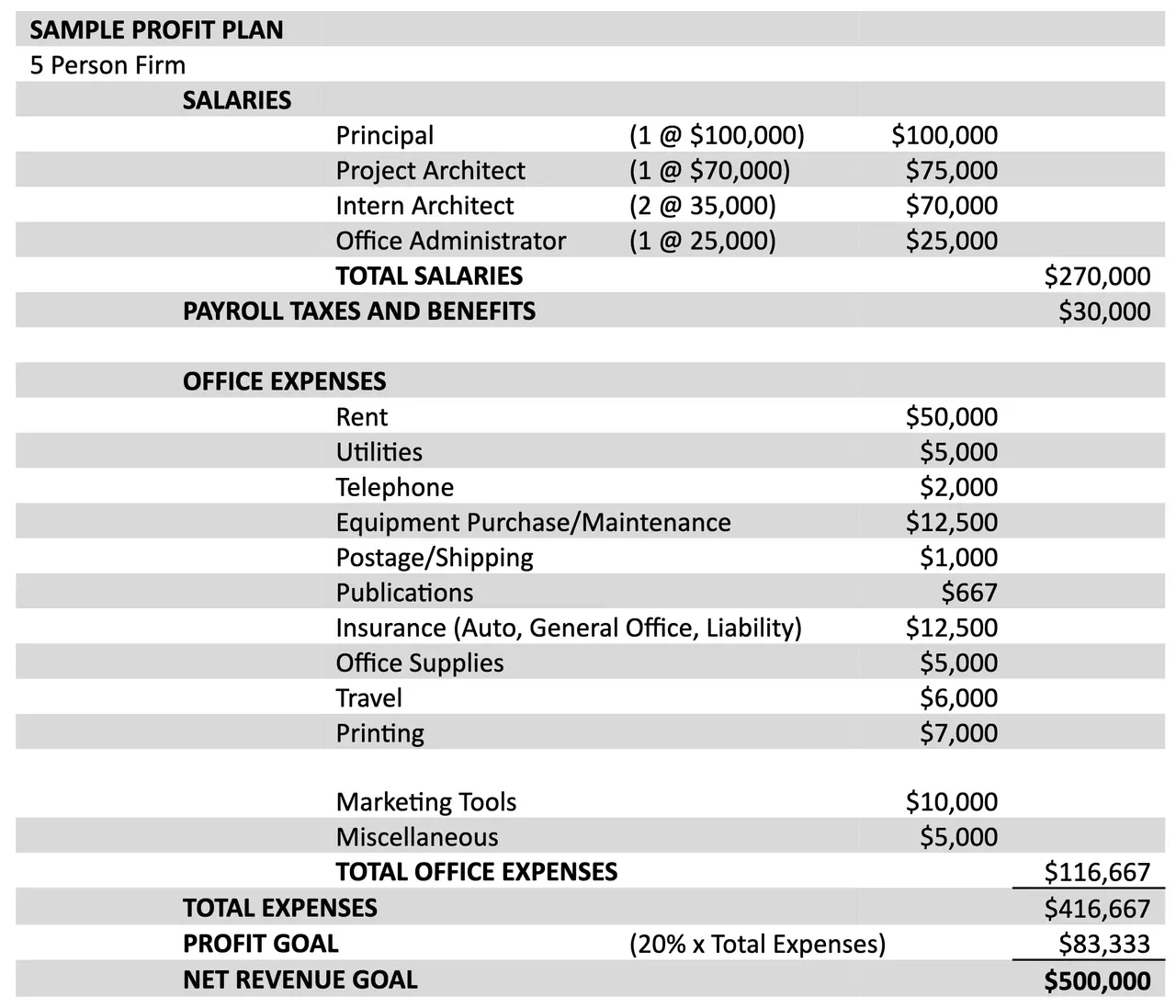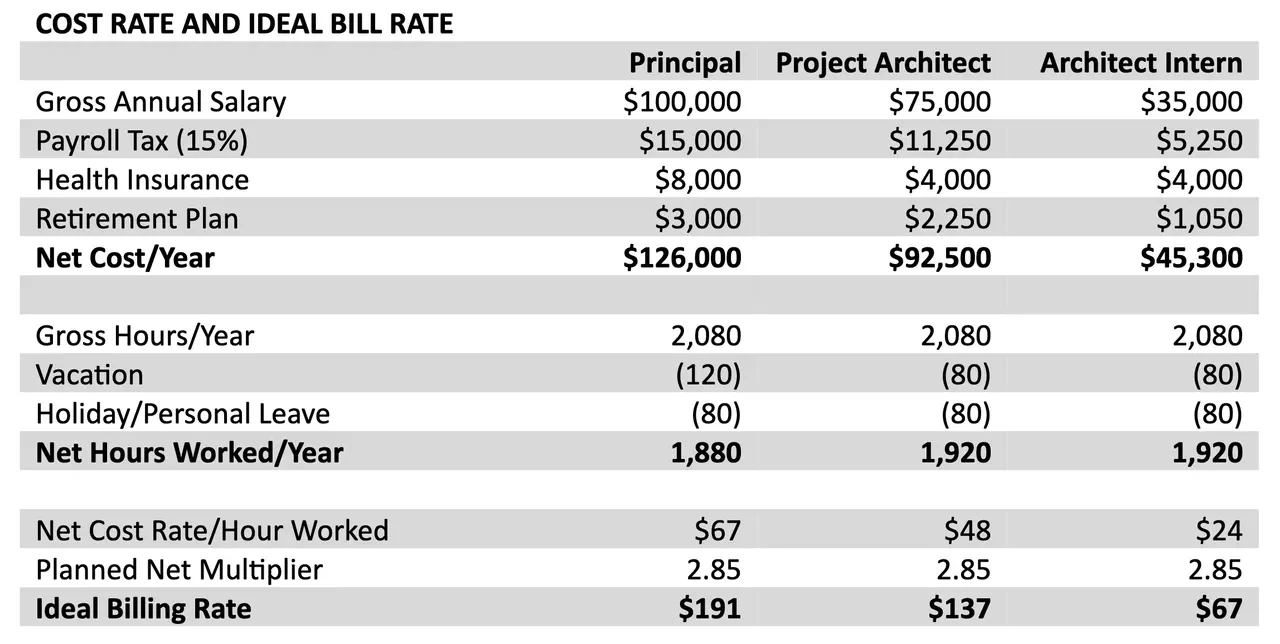Financial Management, Part 2: Technology and Examples
INTRODUCTION
In my previous article, I made a strong case for why your small firm needs to think like a business and not just like an architect. Your financial health starts with creating an Operating Budget – also known as a Profit Plan. Why a profit plan? Because you’re in business to make money, that is profit. Remember, no profit equals no business.
I’m going to share with you how to develop the simplest, most bare-boned version of a Profit Plan that is helpful to any small or emerging firm. So grab a pencil, a piece of paper, and a cup of coffee. Turn off your email and silence your phone. This is dry material for an architect, but essential information you need to know.
There are three steps you need to take when creating a profit plan:
Estimate your expenses. Don’t include any of those that are reimbursed by your client (e.g., printing, travel, pass-through consultant fees, etc.).
Set a Profit Goal. This is generally considered your return on investment (ROI). It’s a percentage of your total expenses. All the effort, and money, you put into the business should return you a profit. You would expect this if you invested the money in something else, like stocks, bonds, or real estate. What’s the return you want to see? I recommend 20%. Otherwise, take the money and invest it in the stock market. You’re also pouring your life into these projects, so the return should be commensurate with the effort.
Add your expenses with your Profit Goal to get the Net Revenue Goal. This is called Net because it excludes the reimbursable expenses I mentioned earlier. Your Net Revenue Goal is what you plan to invoice your clients for your services. In the sample profit plan shown below, the Net Revenue Goal is $500,000.
REACHING YOUR PROFIT GOALS
Now that we have set our Net Revenue Goal at $500,000, we need to understand where this revenue comes from. Architects earn their revenue (and profit), by working on projects. So it should come as no surprise that the most common denominator for planning and measuring financial performance is the Direct Salary Expense (DSE). This is the salary cost of the hours charged to projects (your billable time).
We can actually use the sample profit plan to easily calculate our DSE multipliers. These are the numbers that will be used to determine the values, such as the target break-even, profit, and revenue amounts. But in order to do this, we need to know our Efficiency Ratio.
Efficiency Ratio = Direct Salary Expense / Total Salary Expense
or
Direct Salary Expense = Total Salary Expense x Efficiency Ratio
So, how do we know the efficiency ratio for your firm? Well, I don’t. But statistical surveys show that, on average, architectural firms achieve about 65%. This averages all employees (principals and all employees). While Principals may only be 50% efficient (spending 20 of their 40 hours/week billable on projects), Interns may be 95% efficient. Please, no comments about the 40 hours/week. I know, I know.
I use BQE CORE to help manage project finances. Among other things, It’s able to monitor your staff’s efficiency daily, weekly, and annually. You can set targets for them and know if the Efficiency Ratio you are using is realistic. Understand that a low-efficiency ratio equals low revenue potential and a high-efficiency ratio equals high revenue potential.
So let’s modify the sample profit plan above by making adjustments to acknowledge our estimated efficiency ratio:
In the chart above we know that our Total Salary is $270,000. But since we have a 65% efficiency ratio, our Direct Salary Expense is $270,000 x 0.65 = $175,500.
To Pay for DSE: $175,500 / $175,500 = 1.00
To Pay for Indirect Expenses: $241,167 / $175,500 = 1.37
Combined, these give you the Break-Even Multiplier of 2.37
Now, you’ll want profit: $83,333 / $175,500 = 0.47
Therefore, your Planned Net Multiplier is 2.85. This is that magic number, specific to your firm.
SETTING IDEAL BILLING RATES
The Planned Net Multiplier is an incredibly important number to help you determine what the minimum hourly billing rates should be for your staff. So let’s take a look at each staff member:
As long as your office maintains the 65% efficiency rate you must bill your Principal at $191/hour, your Project Architect at $137/hour and your Architect Interns at $67/hour to obtain the desired profit.
Granted, some firms don’t like to look at the global efficiency rate, opting instead to evaluate the Ideal Bill Rate for each employee based on their true efficiency levels. But that’s a discussion that I don’t want to get us involved with at this time.
The final exercise we’ll do at this stage is to calculate the Projected Realizable Income from each of our employees.
As we can see, the Total Realizable Income of $627,200 exceeds the $500,000 we projected in our Profit Plan. To achieve the profit plan, we only need to invoice 80% of our potential. This is a very common position for most firms. Obviously, we would like to bill the full potential, and hopefully you will. Considering that the Principal will spend half of their time on non-billable work, we hope these efforts will continue to bring new work into the firm.
Our next installment will be to discuss the practical applications of your office's financial management.





